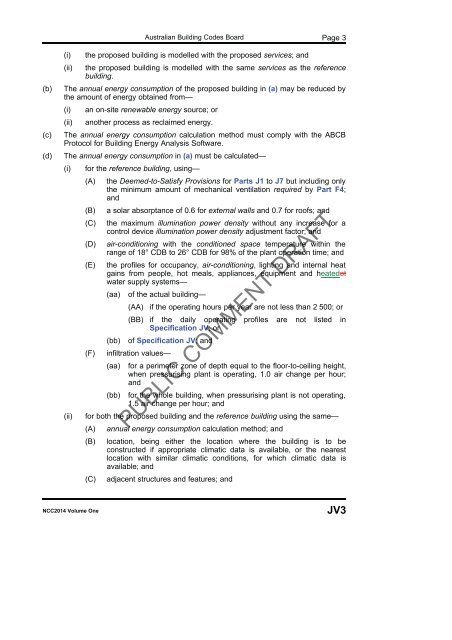PDF | 8 MB - Australian Building Codes Board
PDF | 8 MB - Australian Building Codes Board
PDF | 8 MB - Australian Building Codes Board
You also want an ePaper? Increase the reach of your titles
YUMPU automatically turns print PDFs into web optimized ePapers that Google loves.
<strong>Australian</strong> <strong>Building</strong> <strong>Codes</strong> <strong>Board</strong> Page 3<br />
(b)<br />
(c)<br />
(d)<br />
(i)<br />
(ii)<br />
the proposed building is modelled with the proposed services; and<br />
the proposed building is modelled with the same services as the reference<br />
building.<br />
The annual energy consumption of the proposed building in (a) may be reduced by<br />
the amount of energy obtained from—<br />
(i)<br />
(ii)<br />
an on-site renewable energy source; or<br />
another process as reclaimed energy.<br />
The annual energy consumption calculation method must comply with the ABCB<br />
Protocol for <strong>Building</strong> Energy Analysis Software.<br />
The annual energy consumption in (a) must be calculated—<br />
(i)<br />
(ii)<br />
for the reference building, using—<br />
(A)<br />
(B)<br />
(C)<br />
(D)<br />
(E)<br />
(F)<br />
the Deemed-to-Satisfy Provisions for Parts J1 to J7 but including only<br />
the minimum amount of mechanical ventilation required by Part F4;<br />
and<br />
a solar absorptance of 0.6 for external walls and 0.7 for roofs; and<br />
the maximum illumination power density without any increase for a<br />
control device illumination power density adjustment factor; and<br />
air-conditioning with the conditioned space temperature within the<br />
range of 18° CDB to 26° CDB for 98% of the plant operation time; and<br />
the profiles for occupancy, air-conditioning, lighting and internal heat<br />
gains from people, hot meals, appliances, equipment and heatedot<br />
water supply systems—<br />
(aa)<br />
(bb)<br />
of the actual building—<br />
(AA)<br />
if the operating hours per year are not less than 2 500; or<br />
(BB) if the daily operating profiles are not listed in<br />
Specification JV; or<br />
of Specification JV; and<br />
infiltration values—<br />
(aa)<br />
(bb)<br />
for a perimeter zone of depth equal to the floor-to-ceiling height,<br />
when pressurising plant is operating, 1.0 air change per hour;<br />
and<br />
for the whole building, when pressurising plant is not operating,<br />
1.5 air change per hour; and<br />
for both the proposed building and the reference building using the same—<br />
(A)<br />
annual energy consumption calculation method; and<br />
(B) location, being either the location where the building is to be<br />
constructed if appropriate climatic data is available, or the nearest<br />
location with similar climatic conditions, for which climatic data is<br />
available; and<br />
(C)<br />
PUBLIC COMMENT DRAFT<br />
adjacent structures and features; and<br />
NCC2014 Volume One<br />
JV3
















